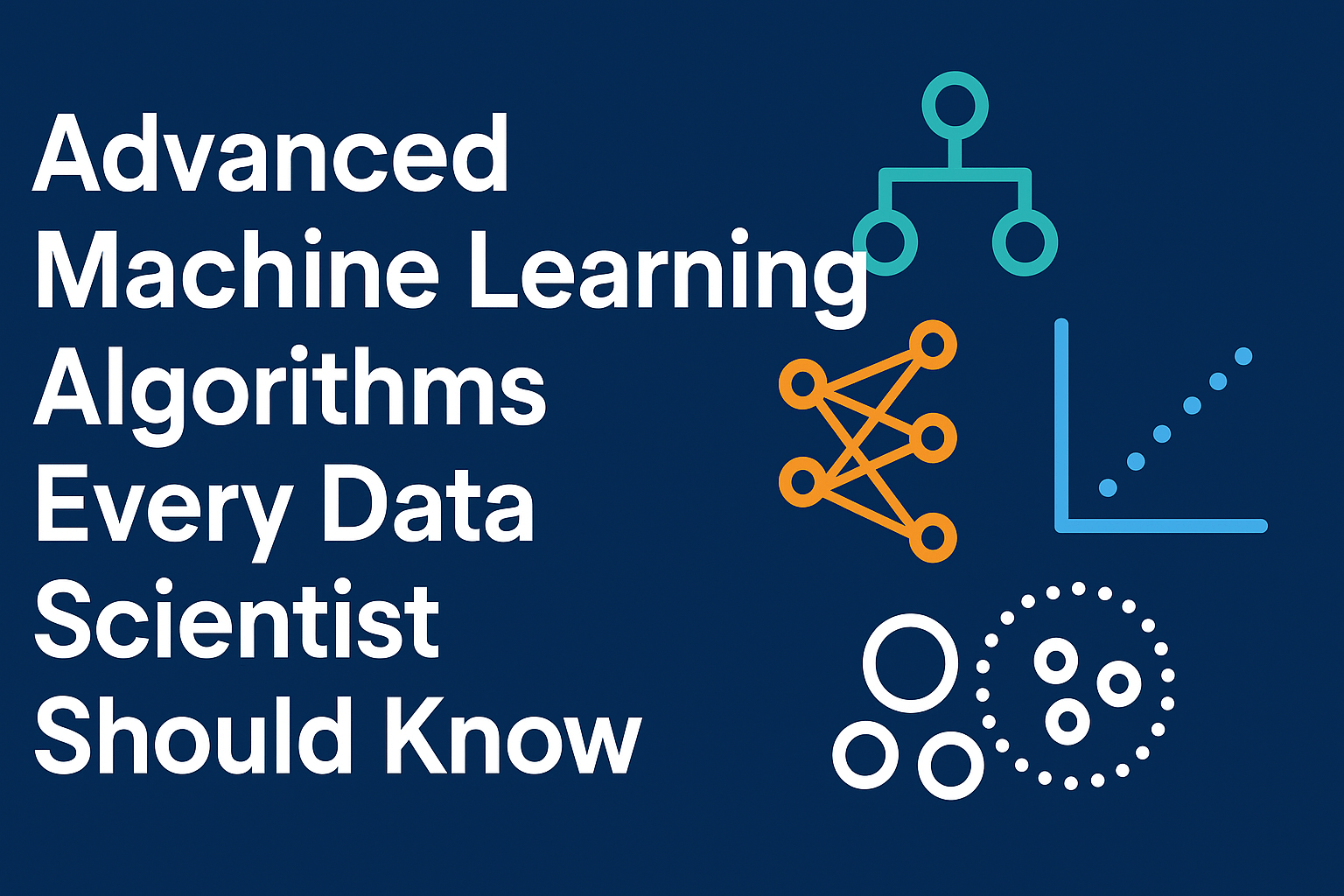Advanced Machine Learning Algorithms Every Data Scientist Should Know

Machine learning (ML) is transforming industries by enabling systems to learn from data and make intelligent decisions. While foundational algorithms like linear regression and decision trees form the bedrock of data science, mastering advanced machine learning algorithms is key to solving complex challenges and enhancing model performance. If you’re a data scientist looking to level up your skills, understanding these algorithms is crucial.
Let’s dive into some of the most powerful machine learning algorithms that every data scientist should be familiar with.
1. Support Vector Machines (SVM)
Support Vector Machines (SVM) are powerful tools for both classification and regression tasks. The goal of SVM is to find the best hyperplane that separates data into different classes. Using the kernel trick, SVM can handle non-linear data, making it one of the most effective algorithms for complex datasets.
Why You Should Use SVM:
- Works well for high-dimensional data
- Handles both linear and non-linear data
- Popular in applications like text classification and bioinformatics
2. Random Forest
Random Forest is an ensemble method that uses multiple decision trees to enhance predictive accuracy. By introducing randomness during the tree-building process, Random Forest reduces the risk of overfitting, making it one of the most robust algorithms.
Why You Should Use Random Forest:
- Reduces overfitting by averaging multiple trees
- Works well for both regression and classification
- Can handle large datasets and missing values effortlessly
3. Gradient Boosting Machines (GBM)
Gradient Boosting builds strong predictive models by combining several weak learners, usually decision trees. Each subsequent tree is trained to correct the errors of its predecessors, leading to a highly accurate model.
Why You Should Use GBM:
- Improves model performance by combining weak learners
- Can be customized for different loss functions
- Popular variants like XGBoost and LightGBM are highly efficient
4. K-Nearest Neighbors (KNN)
K-Nearest Neighbors (KNN) is a simple algorithm that works by finding the closest ‘k’ data points to a given input and predicting the output based on their labels or values. KNN doesn’t require explicit training, making it a versatile tool for many data science tasks.
Why You Should Use KNN:
- Simple to implement and easy to understand
- Non-parametric and doesn’t assume any specific data distribution
- Effective for smaller datasets
5. Deep Learning (Neural Networks)
Deep learning is a subfield of machine learning that uses artificial neural networks with many layers to learn complex patterns in data. These deep networks have revolutionized fields like computer vision, natural language processing (NLP), and speech recognition. Deep learning models can learn hierarchical representations of data, making them ideal for processing large amounts of unstructured data, such as images, videos, and text.
Neural networks consist of layers of neurons, where each neuron receives input from the previous layer, processes it, and passes the output to the next layer. The depth of the network allows it to learn increasingly abstract features of the data, which is what makes deep learning so powerful.
Why You Should Use Deep Learning:
-
Ideal for large, unstructured data: Deep learning excels in tasks that involve large datasets, such as image and video recognition, NLP, and more.
-
Achieves state-of-the-art results: Deep learning models have achieved groundbreaking results in many fields, outperforming traditional algorithms in tasks like image classification and language translation.
-
Requires significant computational resources: Deep learning models are computationally intensive and require large amounts of labeled data to train effectively.
6. Principal Component Analysis (PCA)
Principal Component Analysis (PCA) is a dimensionality reduction technique that helps simplify complex datasets by reducing the number of variables while retaining the most important information. PCA identifies the principal components (directions of maximum variance) in the data and projects the data onto these components, effectively reducing its dimensionality.
PCA is commonly used for exploratory data analysis, feature extraction, and preprocessing for machine learning models. It is particularly useful when you have high-dimensional data that can be difficult to visualize or analyze effectively.
Why You Should Use PCA:
-
Reduces data complexity: PCA helps simplify datasets by reducing the number of features, making it easier to analyze.
-
Improves computational efficiency: By reducing dimensionality, PCA makes it faster to train machine learning models.
-
Enhances model performance: By eliminating noise and redundant features, PCA can improve the performance of downstream machine learning models.
7. Reinforcement Learning (RL)
Reinforcement Learning (RL) is a type of machine learning where an agent learns to make decisions by interacting with its environment. The agent receives feedback in the form of rewards or penalties, which helps it learn the best strategy for maximizing cumulative rewards over time. RL is widely used in applications like robotics, game playing (e.g., AlphaGo), and autonomous driving.
One of the key features of RL is its ability to learn from its mistakes, which makes it suitable for sequential decision-making problems. The agent continuously adjusts its actions based on the outcomes of previous decisions, allowing it to improve its behavior over time.
Why You Should Use RL:
-
Solves sequential decision-making problems: RL is ideal for problems that require a series of decisions, such as game AI or autonomous vehicles.
-
Learn through exploration and exploitation: RL teaches agents to balance exploring new strategies and exploiting known ones for maximum rewards.
-
Powerful in real-time environments: RL can be applied in dynamic environments where the agent needs to adapt its behavior based on feedback.
Conclusion: Mastering Advanced Machine Learning Algorithms
For data scientists looking to stay competitive in an increasingly data-driven world, mastering advanced machine learning algorithms is crucial. These algorithms not only offer powerful tools for analyzing complex datasets but also enable more accurate and efficient predictions. Whether you’re working with high-dimensional data, handling non-linear relationships, or building decision-making systems, these advanced techniques provide the versatility needed to solve real-world problems.
If you’re looking to gain hands-on experience with these algorithms, consider joining a Data Science Training Course in Noida, Delhi, Lucknow, Nagpur, and other parts of India. These courses provide a structured environment where you can learn and apply machine learning techniques effectively.




